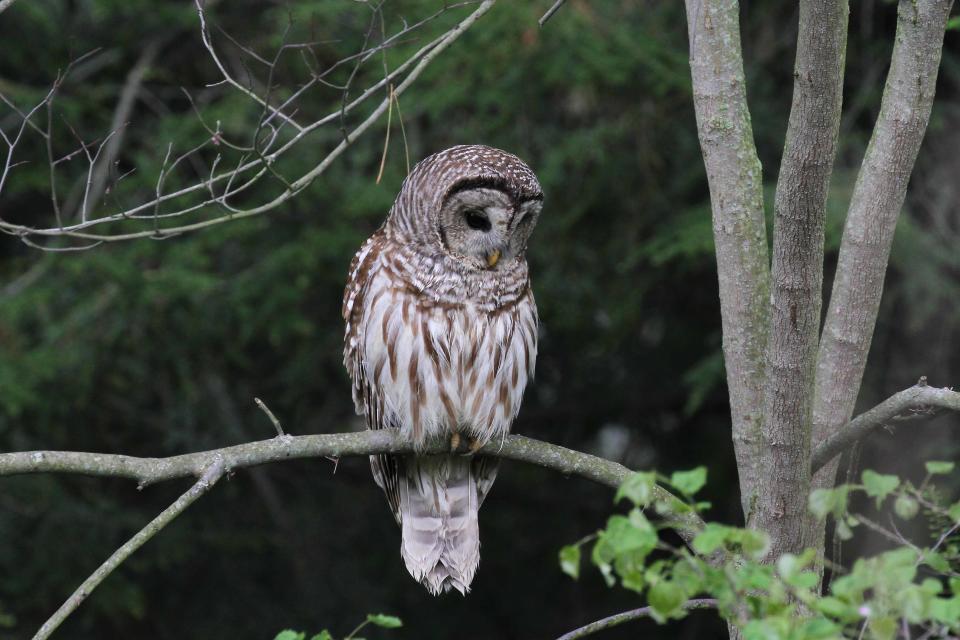Are you killing owls without even knowing it?
Did you kill this owl? Oh, not intentionally. Of course not. But maybe indirectly?
As fall approaches and mice seek winter protection inside man-made structures, people often resort to poison. According to AudubonMagazine.org, if you’ve used so-called second-generation anticoagulant rodenticides, rat poisons sold under various popular brand names, you’ve likely killed owls — as well as hawks, eagles, vultures, and even mammals like cats, foxes, and other rodent eaters.
Here’s how. Rodenticides kill by thinning an animal’s blood. Death results from internal bleeding. While of course owls don’t eat the rodenticides, they do come into the picture indirectly.
From the time a mouse or rat first eats poison, several days pass before it dies. Meanwhile, it returns to the bait repeatedly, ultimately ingesting many times the lethal dose. The rodent grows lethargic, unable to dart to cover, and becomes an easy target for its natural predators, including owls and other critters both feathered and furred. When any critter feasts on the easy catch, it ingests a massive doze of rodenticide.
In turn, those critters, including owls, suffer from secondary poisoning. They, too, die from internal bleeding, usually stomach hemorrhaging. But in a worse-case scenario, an adult owl feeds the mouse to its babies. The owlets die, too.

But there’s even more to this horrible scenario:
When we kill owls and other mouse and rat predators, we’re killing the very animals that nature intended to control rodents. If we eliminate natural rodent control, the rodent ppulation will grow exponentially. You see where this is going, right?
More: How did cattle egrets get from Africa to the Evansville area?
According to a ScientificAmerican.org report, two states for which statistics are available — California and New York — reveal staggering numbers. A 2002 study verified that New Yorkers in eight zip codes applied 20 tons of rodenticides annually. A 2004 study revealed that Californians purchased 10 million pounds annually. The Tri-State likely uses proportionately similar amounts. You can do the math.
In 2011, new EPA rules went into effect. But three major manufacturers were exempt, and professional exterminators, farm workers, warehouses, and other commercial installations were excluded. Rodenticides remain readily available.
According to Audubon author Ted Williams, “There’s no safe place or safe delivery system for second-generation rodenticides.”
Okay, let’s be honest. Mice or rats invading one’s premises cause known negatives; rodents carry disease. So what’s a responsible person to do?
Audubon posts this message:
“Safe alternatives include single- and multiple-entrance snap traps, electrocuting traps, glue traps (provided you use them only indoors and frequently dispatch stuck rodents), and even first-generation baits (as opposed to the second-generation baits referenced above) with these active ingredients: chlorophacinone, diphacinone, diphacinone sodium salt, warfarin, and warfarin sodium salt.”
Audubon also recommends a “better mouse trap:"
Run a metal rod through holes drilled in the center of both lids of an emptied tin soup can so the can becomes a spinning drum. Fasten both ends of the rod to the top of a plastic bucket via drilled holes. Coat the can with peanut butter. Fill the bucket with water and a shot of liquid soap (to break the surface tension and thus facilitate quicker, more humane drowning). Rodents jump onto the can; it spins them into the water.
Using the trap at his fishing camp, Williams killed 37 mice over three months. No owls died.
For more information about birds and bird habitat, see Sharon Sorenson’s books How Birds Behave, Birds in the Yard Month by Month, and Planting Native to Attract Birds to Your Yard. Follow daily bird activity on Facebook at SharonSorensonBirdLady, or email her at chshsoren@gmail.com.
This article originally appeared on Evansville Courier & Press: Poisons kill owls, hawks, eagles and vultures

